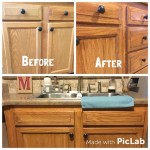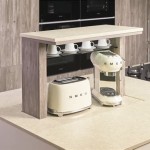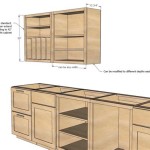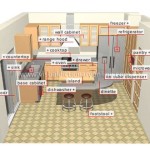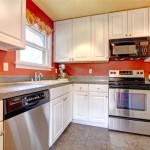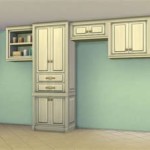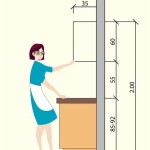Pictures Of Kitchen Cabinets With Knobs And Handles: A Comprehensive Guide
Kitchen cabinets form the backbone of a functional and aesthetically pleasing kitchen. Their design and hardware significantly influence the overall style of the space. One critical decision in cabinet design involves selecting the appropriate knobs and handles. This article provides a comprehensive exploration of kitchen cabinets with knobs and handles, delving into design considerations, style options, material choices, and installation guidelines. Examining pictures of diverse kitchen cabinet configurations will illustrate the practical application of these principles.
Understanding the Impact of Knobs and Handles on Kitchen Design
Knobs and handles are not merely functional components; they are integral design elements that can enhance the visual appeal of kitchen cabinets. The style, size, and finish of the hardware can dramatically alter the perception of the cabinets and the overall kitchen. A simple, understated knob can complement a minimalist design, while an ornate handle can add a touch of elegance to a traditional kitchen. The hardware also contributes to the tactile experience of using the kitchen, influencing the user's impression of quality and craftsmanship.
Consider the existing aesthetic of the kitchen when selecting knobs and handles. A modern kitchen might benefit from sleek, geometric hardware, while a farmhouse-style kitchen could embrace rustic or vintage-inspired options. The finish should also complement the cabinet color and other hardware in the kitchen, such as faucets and light fixtures. A cohesive design approach will create a unified and harmonious space.
Beyond aesthetics, ergonomics play a key role in hardware selection. Handles are generally easier to grip than knobs, especially for people with arthritis or mobility limitations. The size and shape of the handle should be comfortable to hold and use, ensuring ease of opening and closing cabinet doors and drawers. Proper hardware placement is also crucial for accessibility and functionality.
Pictures of kitchens cabinets that showcase differing styles of knobs and handles illustrate these factors. In some designs, the hardware is intended to blend seamlessly with the cabinets, creating a subtle and understated look. Conversely, other designs use the hardware as a focal point, adding visual interest and contrast. Each approach serves a different design goal and can be tailored to the specific preferences of the homeowner.
Exploring Different Styles of Knobs and Handles
The market offers a vast array of knob and handle styles, each with its distinct characteristics and appeal. Some popular styles include:
Round Knobs:
These are a classic and versatile choice, suitable for a wide range of kitchen styles. They are typically simple and understated, making them a good option for minimalist or transitional kitchens.Square Knobs:
Square knobs offer a more modern and geometric look. They pair well with contemporary cabinet designs and can add a touch of sophistication to the space.Bar Handles:
Bar handles are long, sleek handles that are typically used on drawers and larger cabinet doors. They offer a comfortable grip and a modern aesthetic.Pull Handles:
Pull handles come in a variety of shapes and sizes, offering a wide range of design options. They can be curved, arched, or straight, and are often used on cabinet doors.Cup Pulls:
Cup pulls are a vintage-inspired option that is often used in farmhouse or transitional kitchens. They have a curved shape that is comfortable to grip and adds a touch of charm to the space.Novelty Knobs and Handles:
These are decorative options that can add a unique and personal touch to the kitchen. They may feature intricate designs, unusual shapes, or incorporate materials like glass or ceramic.
Pictures of kitchen cabinets showcasing different styles highlight the impact of each type. A kitchen with Shaker-style cabinets might feature simple round knobs or cup pulls, while a modern kitchen could incorporate sleek bar handles. The choice of style should align with the overall design concept and the homeowner's personal preferences.
The size of the knob or handle should also be proportionate to the size of the cabinet door or drawer. Small knobs can look lost on large drawers, while oversized handles can overwhelm small cabinets. A balanced approach is key to achieving a visually appealing and functional design.
Furthermore, consider the ease of cleaning and maintenance when selecting hardware. Some finishes are more prone to fingerprints or smudges than others. Opting for durable and easy-to-clean materials will help maintain the appearance of the hardware over time. Stainless steel, brushed nickel, and oil-rubbed bronze are generally good choices for durability and ease of maintenance.
Material Considerations for Knobs and Handles
The material of knobs and handles plays a significant role in their durability, appearance, and cost. Some common materials include:
Metal:
Metal is a popular choice for knobs and handles due to its durability and versatility. Common metal options include stainless steel, brass, bronze, nickel, and chrome. Each metal offers a different finish and level of corrosion resistance.Wood:
Wood knobs and handles can add a warm and natural touch to the kitchen. They are often used in farmhouse or rustic kitchens. Wood hardware requires regular maintenance to prevent damage from moisture and wear.Glass:
Glass knobs and handles can add a touch of elegance and sophistication to the kitchen. They are available in a variety of colors and designs. Glass hardware is more fragile than metal or wood and may require more careful handling.Ceramic:
Ceramic knobs and handles offer a wide range of colors and patterns. They are often used in vintage-inspired or eclectic kitchens. Ceramic hardware can be prone to chipping or cracking.Plastic:
Plastic knobs and handles are a budget-friendly option. They are available in a variety of colors and styles. Plastic hardware is less durable than metal or wood and may not be suitable for high-use areas.
Pictures of kitchen cabinets showcasing hardware made from different materials illustrate the aesthetic impact of each option. Metal hardware often offers a sleek and modern look, while wood hardware provides a warmer and more rustic feel. The choice of material should be based on the desired aesthetic, budget, and durability requirements.
The finish of the hardware is also an important consideration. Common finishes include polished, brushed, matte, and antique. The finish should complement the cabinet color and other hardware in the kitchen. A consistent finish throughout the kitchen will create a cohesive and unified design.
When selecting materials, consider the potential for tarnishing or corrosion. Coastal environments or kitchens with high humidity levels may require more durable materials and finishes. Stainless steel and brass are generally good choices for corrosion resistance.
Installation Guidelines for Knobs and Handles
Proper installation is crucial for ensuring the functionality and longevity of knobs and handles. Accurate placement and secure attachment are essential for preventing loose hardware and damage to cabinet doors and drawers.
Before installation, carefully measure and mark the desired location for each knob or handle. Use a template or jig to ensure consistent placement across all cabinets and drawers. This will create a uniform and professional look.
When drilling holes for screws, use the correct drill bit size to prevent splitting the wood. Start with a pilot hole and gradually increase the size of the drill bit until it matches the screw size. Avoid over-tightening the screws, as this can damage the cabinet door or drawer.
For drawers, consider the drawer size and weight when selecting the appropriate hardware. Larger and heavier drawers may require longer and more substantial handles for easier opening and closing. The handles should be securely attached to the drawer front to prevent them from coming loose over time.
For cabinet doors, consider the door style and thickness when selecting the appropriate hardware. Thicker doors may require longer screws to ensure a secure attachment. The hardware should be positioned in a way that is comfortable to grip and does not interfere with the door's operation.
Pictures of kitchen cabinets illustrating proper hardware placement can be helpful in guiding the installation process. Pay attention to the alignment of the hardware and the overall balance of the design. Professional installation is recommended for complex or custom cabinet designs.
Regularly inspect the hardware for loose screws or damage. Tighten any loose screws and replace any damaged hardware to maintain the functionality and appearance of the cabinets. Proper maintenance will extend the life of the hardware and prevent further damage to the cabinets.
Choosing the right knobs and handles for kitchen cabinets involves careful consideration of style, material, and installation. Visual resources, such as pictures of various kitchen cabinet configurations, can be instrumental in making informed decisions. By understanding the impact of hardware on the overall design and functionality of the kitchen, homeowners can create a space that is both beautiful and practical.

How To Choose Between Knobs Or Pulls On Kitchen Cabinets

62 Unique Kitchen Cabinet Hardware Ideas For Your Home Best Cabinets Handles

A Guide To Updating Your Kitchen Cabinet Hardware Bella Tucker

How To Mix And Match Your Kitchen Cabinet Hardware

Learn How To Place Kitchen Cabinet Knobs And Pulls Cliqstudios

Cabinet Hardware Placement Guide For Shaker Cabinets

Kitchen Cabinet Hardware Ideas The Home Depot

Cabinet Knob Pulls Vs Handles Refurbishing Ideas Doors N More

Kitchen Cabinet Pulls Home Furniture Design Installing Cabinets Handles And Knobs

Kitchen Cabinet Knobs Pulls And Handles
Related Posts

